A Fifteen foot Beachcruiser
for Sail, Oar, and Small Outboard
Phoenix III was designed for
the builder of the first boat, Paul Hernes. Paul came
to me in search of plans for a dinghy which could
be sailed fast and far, rowed in such a way as to
be more pleasure than pain, and to be able to accommodate
a small outboard motor if the conditions required
it.
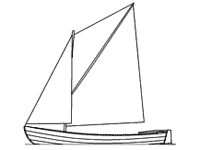 |
Phoenix III
(click images
to enlarge) |
As it happened, I already had a design which I had
been working on for many years. She was to be the
perfect beachcruiser for my own use, incorporating
my idea of the optimum physical dimensions for solo
and two-up cruising. The modeling was done using a
wooden half model laid out according to the principal
dimensions I had settled on after many years of small
boat sailing and rowing.
Once the modeling was complete, I made a pantograph
which allowed me to take off the sections, which I
then drew up as a standard set of lines on my drawing
board. These lines remained dormant for about six
years until I was approached by Paul Hernes, who was
in search of such a design. At the time I was moving
workshop and house, so did not have free access to
my board. As the job needed to be done straight away,
I was forced to teach myself CAD – something
I had always said I would never do. Oh well, we live
and learn! It turned out to be a blessing in disguise,
and it has had cascading benefits.
In order to get the lines into CAD, I initially put
my hand-drawn dimensions into Greg Carlson’s
Hulls program to generate dxf files, and
then transferred the dxf’s into a conventional
(i.e. nothing to do with boat design) drafting program
– Autocad’s entry-level program, Autosketch.
A major advantage of having taken the step of using
a CAD program is that the need for lofting has been
removed. The dimensions shown on the bulkheads and
molds are accurate enough for direct use, and have
been tested by the builder of the prototype.
She has been given a spritsail with a jib set flying
(i.e. a jib which is not attached to a separate stay).
The spritsail sloop is one of the few sloop rigs which
can carry a jib effectively without stays, shrouds
or backstays of any type. This is because the sprit
places the head of the mainsail in tension, which
is in turn translated into tension in the luff of
the jib. Therefore, there are no stays on this boat
at all – just place the mast into the step and
partner, and off you go!
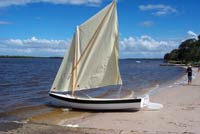 |
The spritsail
sloop is one of the few sloop rigs which can
carry a jib effectively without stays, shrouds
or backstays of any type. |
Considerable thought went into centreboard placement
and design, as I really wanted the boat to balance
under mainsail alone as well as under full sail. This
she does quite well. In heavy conditions, raising
the centerboard a bit eases the boat and moves the
centre-of-lateral resistance aft. I’ve sailed
her in thirty knot winds under reefed mainsail alone,
and was quite comfortable (although I am battle hardened,
as I also sail a wooden International Finn!).
The centerboard is of generous area, and the centerboard
case extends under the main thwart. With a centerboard
shape reminiscent of that seen in Swampscott Dories,
PhoenixIII’s centerboard provides plenty of
‘bury’ in the case when fully lowered,
while not interfering with the correct positioning
of the rowing thwart.
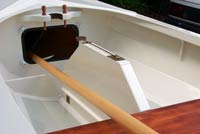 |
PhoenixIII’s
centerboard provides plenty of ‘bury’
in the case when fully lowered, while not interfering
with the correct positioning of the rowing thwart.
|
The forward end of the centerboard case has been
angled back so that it doesn’t interfere with
the mast stepping process. There is no need to lift
the mast to put it through a hole in the deck –
just place the foot of the mast in the step and push
it forward into the mast partner. The whole process
is a one-handed affair, which takes about thirty seconds.
I’ve long held the view that the smaller a
boat is, the more she will be used, and with this
in mind, Phoenix III has been kept to modest
dimensions: -
Length Over All |
/ |
15ft 1-1/2ins / 4610mm |
Breadth |
/ |
4ft 9in / 1457mm |
Draft |
/ |
6in / 153mm |
Weight |
/ |
approximately 132lbs / 60kg |
Displacement |
/ |
595lbs / 270 kg |
Sail Area |
/ |
104sq.ft. / 9.64sq.m |
The shape of the hull is a compromise, as is the
case with all boats. The breadth has been kept reasonably
small so that she can be rowed efficiently with easy-to-stow
seven foot oars. A case could be made for a wider
hull in order to increase initial stability and sail-carrying
power, but I kept my nerve and stayed with a narrow
boat. In addition to helping make the boat a pleasure
to row, the slender breadth reduces weight, and results
in a fine entry angle at the bow. The fine bow angle
reduces pounding and helps to make her a dry boat.
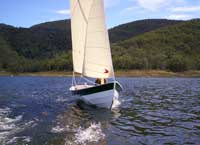 |
In addition
to helping make the boat a pleasure to row,
the slender breadth reduces weight, and results
in a fine entry angle at the bow. |
The hull structure of Phoenix III is unusually
open and free of clutter, relying on built-in components
such as watertight bulkheads, rowing thwart and centerboard
case to add rigidity to the glued-lapstrake (clinker/plywood)
skin. The glued-lapstrake construction method produces
a stressed-skin hull with a very good stiffness-to-weight
ratio. Bonding of major components like the bulkheads
adds greatly to the strength with little added weight.
I’ve put plenty of sail onto this boat, and
for her to be able to stand up to it the rig needs
to be kept low. The whole rig can easily be stowed
within the length of the boat, making for hassle-free
trailering.
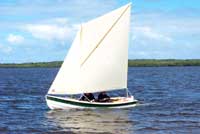 |
The whole rig
can easily be stowed within the length of the
boat, making for hassle-free trailering. |
Boomless sails are nice and simple, but they only
drive a boat well if the sheeting geometry is correct.
Phoenix III has been carefully designed from the outset
to be able to operate without a boom on the mainsail.
For those who prefer a boom (to ease sheeting loads,
or to free up the choice of sheeting points), details
for an optional boom are included with the plans package.
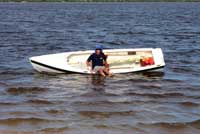 |
She supports
the weight of a 90kg (200lb) person on the gunwale! |
She supports the weight of a 90kg (200lb) person
on the gunwale!
There are buoyancy tanks built-in under the fore
and aft decks, as well as under the aft thwart. A
small, self-draining outboard motor splash well is
also built into the aft deck as can be seen in the
next photo.
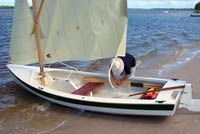 |
A small, self-draining
outboard motor splash well is also built into
the aft deck as can be seen in this photo. |
If you want to row, the proportions of the rowing
position must be correct, and the oars must be of
the proper length. Also, the freeboard (i.e. the height
of the sides of the boat above the waterline) needs
to be quite low. Phoenix III has been designed to
fit in with all the old rules-of-thumb, and she rows
very easily. Below is a photo of Paul Hernes rowing
on the day of the very first launching. The centerboard
case is shaped so as to allow the oarsman to lean
back at the end of the stroke.
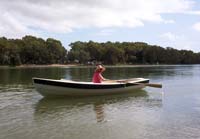 |
Paul Hernes
rowing on the day of the very first launching.
|
The hull is built upside-down on a normal strongback,
details of which are in the plans. There are four
permanent bulkheads and a number of temporary station
molds made from MDF or construction ply.
All major components of the boat are made from 6mm
(1/4”) marine plywood, with small amounts of
12mm (1/2”) for things such as the centerboard
and rudder laminations. Paul Hernes used five sheets
of 6mm (1/4”) and part of a sheet of 12mm (1/2”).
While she is not an ‘instant boat’, a
determined first time builder should be able to make
a good job of construction as long as he or she does
some homework first. I strongly recommend Iain Oughtred’s
excellent book, “Clinker
Plywood Boatbuilding Manual” as
well as John Brooks and Ruth Anne Hill’s book,
“How
To Build Glued-Lapstrake Wooden Boats”.
As was so often advised by William Atkin and L. Francis
Herreshoff, do not make changes to the design without
consulting the designer. Everything in the design
has been carefully thought through, and alterations
could have serious consequences.
The plans consist of twenty-five A3 sheets of drawings,
a small selection of photos, and an illustrated instruction
manual of forty-odd pages. There are two separate
editions of the plans – Imperial and Metric
– your choice
Price for the package is US$145.00 (incl. airmail
postage) from Duckworks https://www.duckworksbbs.com/
Australian customers can purchase directly from me,
Ross Lillistone, at Bayside Wooden Boats, PO Box 152,
ESK, QLD 4312
Email: bsam9350@bigpond.net.au
Reduced size study plans are available for $15.00,
refundable with purchase of complete plan set.

More about Phoenix III:
|